Guard Dog Global Jam: Bill Plympton’s Worldwide Collaboration Endeavour
In September of last year Bill Plympton began one of his more ambitious short film projects to date: A worldwide reinvention of “Guard Dog” (2004), his Oscar®-nominated short released six years previously.
Following a call on his website, Plympton’s proposal was to break the film down, shot-by-shot, assigning each one to a willing volunteer who would reanimate it in any chosen style or medium, the end result visually showcasing the gamut of amateur, independent and professional animation the world over.
A year later, the finished film has earned an award along with a wealth of international screenings, the most recent of which being the prestigious Ottawa International Film and Animation Festival.
On top of its grand reception, the process of putting the film together has served as a unique and remarkable networking opportunity, bringing animation enthusiasts, hobbyists and specialists together and even generating subsequent collaborations within the community. Over the past few months I was able to correspond with fellow Jammers, Plymptoons producer Desiree Stavracos and Mr. Plympton himself to get their impressions of the “Guard Dog Global Jam”.
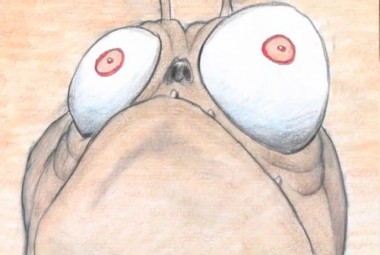
“Guard Dog” (©2004 Plymptoons)
Bill Plympton: “I go to the Florida Film Festival a lot and two years ago they showed this film where a guy went on the internet and found any kind of circle – a wheel, a sun, a ring or whatever – and he pulled them and made an animation out of them, just all these different circles. I thought “Wow, this guy made a film without doing any artwork, I love that!” So I figured, why couldn’t I go on the internet and ask artists to contribute one shot each to make a film?”
Desiree Stavracos: “Generally, my role at Plymptoons is to make sure that any project that Bill conceives of, both in his head and on paper, turns into the finished product the public sees on the screen. That includes (but is not limited to) organizing the storyboards and animation, running a production team and coordinating with outsourced talent such as music composers and sound designers. Bill said to me one day, “I want to make this collaborative re-make of “Guard Dog”. Can you do that?” I said “Yes”, and off I went.”
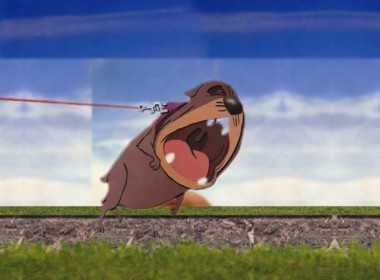
“Once I got my scene, I worked out an exposure sheet to pinpoint the timing. I did the animation on paper and scanned each drawing into Photoshop, rendering them using scans of paper samples and layering techniques. All the elements were put together in Digicel Flipbook. I’m sure if I had it to do over again I would change some stuff, but for the most part I’m pleased with my design of the Dog and the animation.” – John T. Quinn
Bill: “I wanted to choose a film that was famous. My first choice was “Your Face” (1987), but there was no way to delineate the shots – maybe I’ll do it in the future, who knows? – “Guard Dog” just seemed much more simple, because there are distinct cuts – I think there are seventy-two shots. Whereas “Your Face” is comprised of one shot with maybe ten different episodes, so it would’ve been very difficult. Plus people love the Dog character, which is good.”
Said ‘Dog character’ had now become something of a Plymptoons mascot; the company’s slobbering, misguided Mickey, so to speak. The only character to make recurring appearances, the luckless pug has been the star of four films to date – “Guard Dog”, “Guide Dog” (2006), “Hot Dog” (2008) and “Horn Dog” (2009), with a fifth – “Cop Dog” – in the making. The character came about when Plympton, seeing the great strides being made on the independent animation scene by the likes of PES and Aleksey Budovsky, made the conscious effort to up his game and create a film as unique and endearing as his classic groundbreaking shorts. The result has resonated with the public far beyond his immediate and previously established fanbase, while retaining all the qualities of (and in some respects, epitomising) the Plymptoons universe.
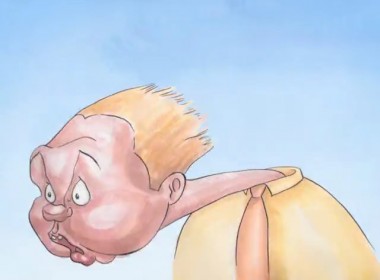
“I drew out my shot entirely by hand using Indian ink and a nib pen, and coloured it with drawing ink. I spend far too much time at the computer during my day job, so I find animating traditionally at a lightbox extremely therapeutic, almost meditative. It was important to me personally to use traditional techniques because I feel that in a way they’re dying out, and I was pleased that I kept the scene true to my natural drawing style and didn’t end up imitating the original. I wanted the man’s neck to become really elastic when the swing hits him – I must have drafted it at least three times because it never came out rubbery enough!” – Amy Sutton
Deseiree:“For the obvious reason, the “Dog” series is unlike all Bill’s other shorts in that the protagonist is an animal, not a human. The less obvious, but stemming from that superficial difference, is that when dealing with the Dog, Bill treats him as his most pure and innocent of characters. I believe he is the most well-intentioned, perhaps an extension of the ‘man’s best friend’ iconography we have placed on dogs? There is no vice to him – everything he does comes from pure-of-heart motives, and we as an audience don’t question that. We feel for him in a way I don’t think we would if he was human.”
Despite the public affection for the Dog and for Bill himself, when the initial call for animators went out back in June 2010, it was met with almost immediate criticism, albeit from a negligible minority. “This is crowdsourcing” accused one poster on Cartoon Brew, another suggesting “Mr Plympton is clearly planning to make money from this and exploit the free work”. While it certainly isn’t unreasonable to maintain a guarded attitude toward online solicitations of free labour from animators at an early stage in their career, the fundamental differences were clear to most. As countered by Amid Amidi: “There are countless nasty corporations and bloodythirsty businessmen out to exploit artists; trying to lump in a lifelong indie who has been an inspiring and positive force in the animation community for decades is a nonsensical and stupid argument.”
Deseiree: “You never really know how any endeavour is going to be received. What I thought was transparently a genuine, fun experiment, got some critical reviews and accusations, which didn’t dissuade us in any way, but it was surprising to read at first.”
The overwhelming majority saw the notion of animating several seconds of footage during a three-month window as far less a demand on their time as an appealing excuse to venture outside of the usual wheelhouse and make a small-yet-valuable contribution to a project that would doubtless be a noteworthy chapter of the Plymptoons legacy. The prevailing attitude was one of excitement and enthusiasm.
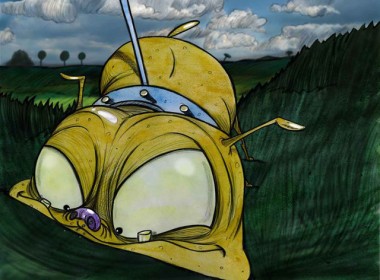
“I love Bill’s style and I consider it my biggest influence, so I tried use his suggestion but in my way. To be honest, I was excited and in a hurry and I think I could have made it better. I was confused at first, I tried some different methods but I prefer the artistic ways of making animation; They may be old but I love them, so I chose paper animation and pencils.” – Fatima Yasrebi
Deseiree: “In the beginning we had quite a scare. We were sending out info and plugging the project wherever we could, trying to get the most submissions as possible when we opened up the scene requests on September 1st. Bill was nervous no one would participate, which in turn made me nervous – also, this was the first non-commercial short that I would be producing for Bill, so I was feeling some serious self-inflicted pressure.”
BILL: “We had a video camera set up, we had a countdown, we were watching the computer waiting for people to register – and nothing.”
Deseiree: “Not one e-mail. Cut-the-silence-with-a-knife kind of moment. To say I felt terrible would be an understatement.”
Bill: “I thought “What’s going on? Maybe people think we’re on the west coast and it’s three hours later”. So we waited for three hours – nothing. I was really disappointed, I thought “This has got to be the stupidest idea I’ve ever had, nobody wants to be part of this experiment” and went home really kind of sad and rejected.”
Deseiree: “Fast-forward two hours, and our office manager asks if I’ve gotten e-mail since noon. I check; No I have not, in fact. I ask Lindsay – same there. I email our service provider from my Gmail – turns out we got so many e-mails at noon that it crashed our server. What a relief! E-mail came back up and we were on our way.”
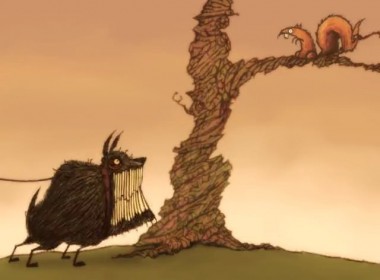
“My chosen shot is created in my own style, in keeping with the spirit of GDGJ. I worked on the scene every day for almost three months after work. Firstly I made an animatic, then I drew every frame and afterwards added colour, that’s the natural way of course! I chose this scene because I was looking for the hardest and longest one to make; I wanted to set the bar very high.” – Filip Grudziel
Bill: “So in the end we’d had somewhere between two-hundred and three-hundred people who wanted to be part of the event!”
Deseiree: “After that, everything else was relatively smooth sailing.”
Amongst the successful applicants were Iran-based animator Fatima Yasrebi, Gilliam/Harryhausen-inspired Disney artist John T. Quinn, James Sugrue of Titmouse Animation in New York, Ansar Sattar of Trinitoons in Trinidad and Tobago, London-based motion graphics designer Amy Sutton, experimental animator and collaboration enthusiast Mike Schneider, animation hobbyist Filip Grudziel, animation student Rebecca Wallace, animation instructor (at Edinboro University in Erie, PA) Jeremy Galante and Lithuanian game designer/animator Julius Liubertas. These and some sixty-plus others – including yours truly – shared an instant bond of enthusiasm and admiration for Plympton’s work and the venture itself. To encounter so many likeminded practitioners gave a strong sense of how significant and influential his work has been, and continues to be.
Amy: “I’ve always loved to draw and paint but animation seemed somehow unattainable to me – I thought you needed to live in Hollywood and be part of a huge studio like Disney. I think that’s why Bill inspired me so much when I first discovered his work – he’s a one-man band.”
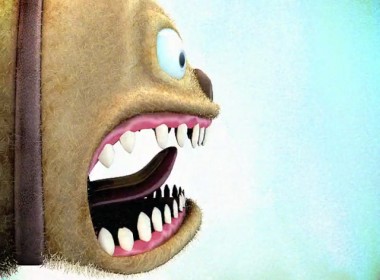
“From the start I planned to do 3D CG animation, I’m just mostly interested in it. But after seeing the whole film as one piece, especially a couple of the better shots, my love for traditional drawn animation returned – not that I didn’t like it before. So I began doodling some animation in this technique.” – Julius Liubertas
Deseiree: “Bill’s “25 Ways to Quit Smoking” (1989) was the first short animated film I saw that wasn’t Disney or Japanese. Seeing this short, and subsequently “Your Face” (1987), “One of Those Days” (1988), “Guard Dog”, and “The Tune” (1992) all while at SVA, changed the way I saw animation forever. It opened my mind to just how limitless the medium of animation can be, and thus not only changed the way I saw animation, but my own potential as an artist.”
Rebecca: “I knew about him way back in the day from my animation books, but I didn’t know about him completely until my first year of college. I really liked the do-it-yourself M.O. and it helped me as a student to be more comfortable with the materials – or lack thereof – that I have.”
MIKE: “My first time seeing Bill’s work was through Liquid Television when I was little. I watched that series religiously and still hold it as the high point of animation. Though I can’t pinpoint how his work has influenced me, you can’t watch Bill’s stuff that many times and not have it scar you forever… in the best possible way, of course.”
James: “One of the aspects I love about Bill Plympton’s work is how he can take seemingly normal looking characters and turn them into surreal images of mind blowing animation. With Bill Plympton’s characters, I always expect the unexpected.”
John: “I appreciate his unique approach to animation, like his design and the texture of his work. I think what I find inspirational about Bill’s work is his singularly recognizable style, both graphically and technically. I think he embraced the limitations – cost, time, execution – of the medium and found a way to make something great.”
Julius: “The first time I stumbled upon Bill’s work was in some kind of ‘dusty screen’ festival in the middle of nowhere! It was his “25 Ways To Quit Smoking”. The style and the situations were hilarious, really fun to watch. So I searched for more of his work and then I found out who the hell Bill Plympton is – one of the best and most talented animators around.”
Filip: “He’s a great artist, I’m impressed by what he’s achieved in his life and hopefully he’ll finally get an Oscar for all that he’s done.”
Rebecca:“Bill works simply, but his films are fantastic – as an aspiring animator, this is extremely encouraging.”
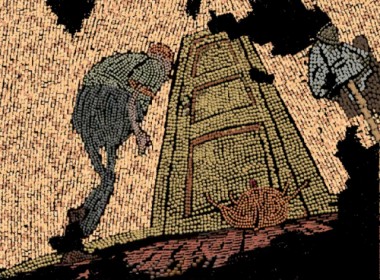
“I’m a big Jan Švankmajer fan, in particular “Dimension in Dialogue, Part One” (1982) which pulls together all sorts of tiny scraps to form a larger picture. Although I would have loved to do it by hand, trying to simulate it in After Effects seemed like an intriguing substitute, and I could bring my laptop anywhere. I like to always walk away from a film having tried something new, and this allowed me to explore particle effects, which I had never really looked into, since I’m more of a traditional guy. I took a few images of dog food pellets, and tried to set them up in a mosaic style, figuring that might also give it a nice conceptual twist. Whether or not it was clear that I used dog food seems negligible when looking at the finished piece – and I’m fine with that. The mosaic animation looks cool, but I don’t think I would have been able to sell the shot without bookending it with the pouring and crumbling, which was definitely rewarding to work on.” – Jeremy Galante
Once the project began there was an instant sense of community, with online groups set up and consistent email correspondence to garner feedback on artwork, concepts and animation tests as they came together.
Bill: “And so we had everybody from this ten-year-old Chinese boy (the prodigious Perry Chen, with whom Plympton recently collaborated on the ambitious Holocaust animation “Ingrid Pitt: Beyond The Forest”) to Disney animators, I went to a festival in Trinidad and Tobago and a guy there said he’d worked on it too.”
Ansar: “I was blessed with the opportunity to debut my completed scene right there at his workshop, both to the audience and to Mr. Plympton himself. He enjoyed my final take and was excited to learn just how far his global experiment had reached.”
Bill: “It’s just amazing how people all over the world did parts of it. The most amazing part for me was the ‘Laughing Girl’. Some of those pieces are so beautiful.”
Said sequence is perhaps the standout moment of the film, in the sense of it being something of a visual punch in the face – a flicker frame extravaganza where every individual frame was outsourced to a different artist to interpret in their own way, as such a collaboration within the collaboration. The sequence was the brainchild of Mike Schneider, who had previously spearheaded the similar mass collaboration project “Night of the Living Dead: Reanimated”.
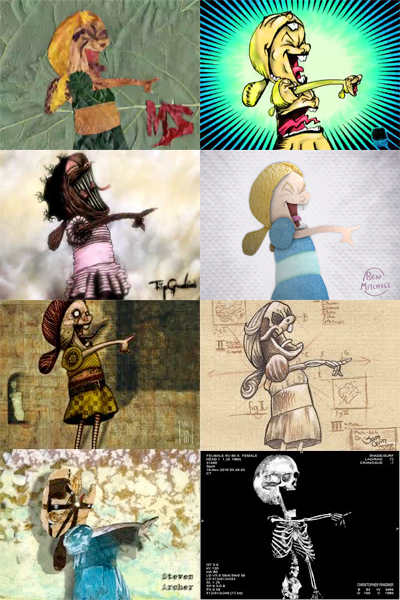
A handful of the illustrations from the ‘Laughing Girl’ segment. Clockwise from top left: Mike Schneider, Tom Furey, Ben Mitchell, Sam Guin, Christopher Panzner, Steven Archer, Grant Fuhst, Filip Gruziel.
Mike: “A few months before GDGJ was announced, an interviewer asked if I was going to do another project like “Night of the Living Dead: Reanimated” that I would do differently. After thinking it over, I answered that I’d love to do one where we were working with the original creator. Not only am I a huge fan of his, this is my kind of project.
“Four seconds isn’t a long time so I used a flicker frame animation technique. Basically, you create a series of templates to define the movement and then approach each frame as a unique piece of still artwork. Naturally, I took part (my frame was collaged out of leaves) but the heavy lifting was finding and coordinating over a hundred artists within such a short period of time. Generally with flicker frame animations there are a lot of interesting ideas but all of the works are usually drawn on the spot. Working with so many professional artists and allowing them each three-plus weeks to do a singular frame of animation takes the process to a whole new level.”
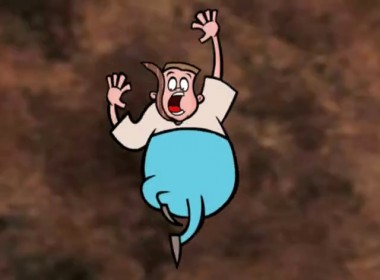
“I was ecstatic when I received the news from Plymptoons that I was accepted…at that point it didn’t matter which scene I got to animate. I was assigned scene 40: ” The guy falls into Ronald Mc Donald’s clothes”. I recreated the scene using Adobe Flash, as I constantly studied the timing of the original. I used different techniques to achieve the final take.” – Ansar Sattar
Bill: “We’d decided to ask artists to send in a still of the technique they’d use after one month, and I think about 90% of the people sent in their still, the other 10% said they were really busy or they weren’t able to come up with an idea. That was a big concern, so we decided to let it go and we would let them give us a drawing when they had more time. Near the end we had about five people who could not finish their animation. The deadline was December 1st I think, and we extended it an extra month to December 29th, and there were five people who still couldn’t finish it. So we had a standby list and called up some of the people who were waiting to take a slot, and they were able to contribute.”
In February 2011 the completed film was privately released and circulated throughout the Global Jam community. Despite the tremendous range of styles, methods of execution and fluctuating degrees of professionalism, by having each shot so meticulously timed and crafted the end result perfectly retains the flow of the original.
Bill: “Some people have commented that some of the work isn’t very professional, but I like that; I like the contrast between really professional work and really innocent, childlike animation – professionals alongside amateurs. I also like the disparity between so many different techniques, whether it’s digital or paint or sculpture or puppets. I think that really makes it a much more interesting film to look at.”
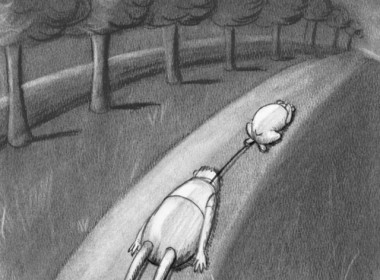
“I originally wanted to do it completely in charcoal. Sadly, I ran out of time due to my studies. So I ended up doing the background in charcoal and all the animation in pencil. I ended up animating it on twos or threes, trying to keep a somewhat slow-motion feel – and to save me time! I almost wish it turned out smoother, even though I wanted the slow-motion feel, but I’m happy with it. The Dog turned out very cute!” – Rebecca Wallace
Fatima: “At first I wasn’t sure because of all the different styles, different animators from different cultures over seventy-two shots and so on. But after I saw it I understood, I love the whole film and never get tired of watching it.”
AMY: “I love every single shot in the finished film – I feel very connected to each of the artists although I’ve never met any of them, as they all must feel the same desire to animate that I feel. It’s such a funny scenario and the schizophrenic variety of the scenes accentuates just how wild the story is. It’s incredible to see how differently the artists visualise each movement, each expression.”
James: “I love the diversity! It was great to see a slew of talented artist and animators come together to add their voice with each shot. Some were cute, creepy, 2D, 3D, stop motion, the possibilities seemed endless! It was a tour de force of experimental animation, and I hope we can continue more ventures like this in the future.”
Julius: “There are couple of shots that really stand out, but as a whole it’s a nice chaotic journey for all “Guard Dog” fans.”
Rebecca: “It’s fascinating to see all the styles. Though I admit the changes can be somewhat distracting to the film itself, I like to watch it shot by shot and see what everyone came up with.”
Mike: “It’s beautiful. Whenever you bring so many talented, passionate people together the results are nothing short of amazing.”
Jeremy: “As for the overall experience, I was pretty blown away by the immediate community that was formed, and loved the openness and feedback of the Facebook group forum. What I think I enjoyed most of all was seeing more of everybody’s personal work, and networking beyond this project. It always reminds me of what a special community animation has and how it can so naturally bring everybody together like family.
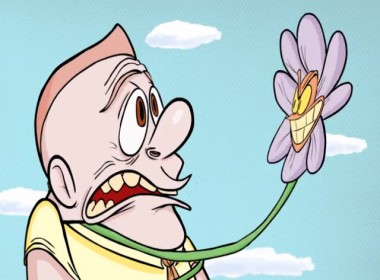
“My shot was only three seconds long, but I made sure it was the most fun three seconds I could animate. I love adding secondary actions, which is why I had the man’s nose flop a bit as he was about to sneeze. I couldn’t have been happier with how it turned out, it was exactly the way I envisioned.” – James Sugrue
ANSAR: “I would definitely take on another challenge like this. This entire experience has humbled me and shown me just how powerful animation can be. It brought global talent together to work as a team towards a common goal. It is an experience that I will cherish for the rest of my life. Congratulations Mr. Plympton…and thank you!”
So, given how enthusiastically the Dog has been received, not just from the perspective of an audience but from those who sought to collaborate on adding a new and varied dimension to the world of Plympton, what lies in store? Surely there’s potential for Dog plushies, apparel, a merchandise line to rival that of his peers amongst the ranks of animated icons?
Bill: “People have asked about t-shirts, and when I get some more time and money I’ll probably start putting out those. Little dolls I think would be great, or sculptures would be really cool. But I don’t wanna take my time doing merchandise and marketing, for me the pleasure is making the films…maybe in the future? I do have four “Guard Dog” films as well as the Global Jam, and I’m working on a fifth now, so I’m hoping that it’ll be part of a package of everything that has the Dog in it.”
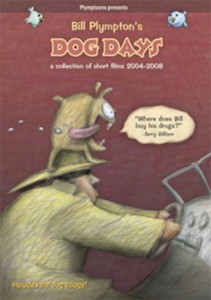 “Guard Dog Global Jam” won the award for Best Experimental Animation at ASIFA-EAST 2011. Recent/upcoming festival screenings include the London International Animation Festival, Ottawa International Animation Festival, Sitges, BendFilm and Chicago International Film Festival.
“Guard Dog Global Jam” won the award for Best Experimental Animation at ASIFA-EAST 2011. Recent/upcoming festival screenings include the London International Animation Festival, Ottawa International Animation Festival, Sitges, BendFilm and Chicago International Film Festival.
“Bill Plympton’s Dog Days”, his most recent collection of animated shorts, is available on DVD and includes the first three Dog films – “Guard Dog”, “Guide Dog” and “Hot Dog”. More DVDs, merchandise and info are all available at plymptoons.com


